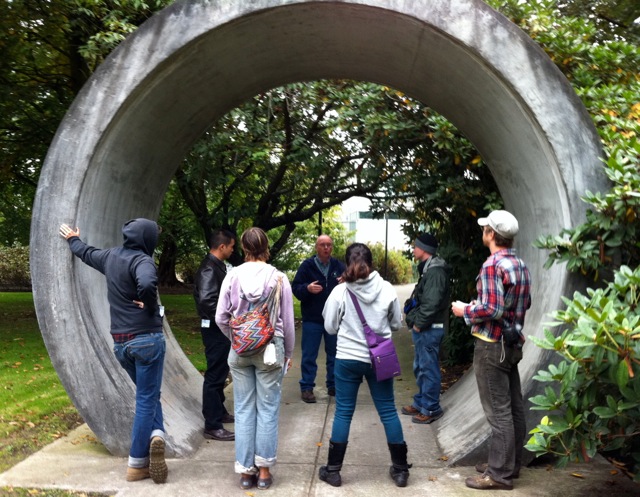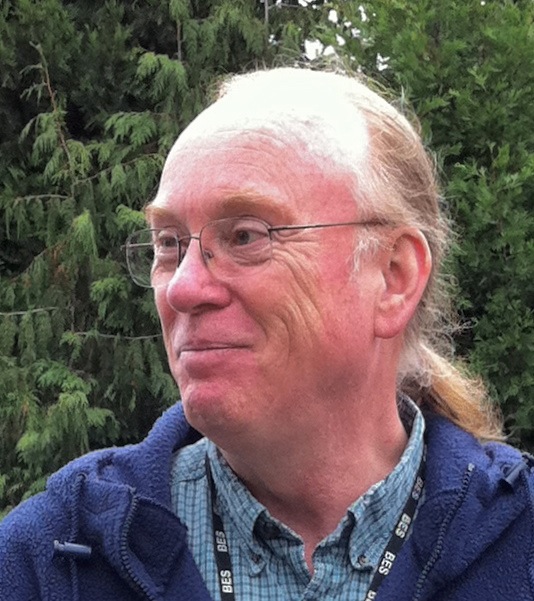Where does it all go? Sanitation tours provide answers.
Where does it all go after we flush? How does it all get managed? How come we know so little about how wastewater treatment systems work?
These are the questions that led us to organize our 2011-12 series of expert-led tours of sanitation facilities. As citizens, we need some understanding of essential infrastructure to influence sound budget and policy decisions regarding urban sanitation and sewers. As human beings who eat and excrete, we also see it as a matter of personal responsibility.
Our October 19, a group of us gathered at the Columbia Boulevard Wastewater Treatment Plant, the largest facility in Oregon for sweepingly mind-boggling tour, certainly one of Portland’s most interesting and informative. The incomparable Mike Stebbins, who has spent his 35 year career in operations at the plant, took us on a 2-hour-and-45-minute journey through the intricacies, mysteries and magic of the treatment process. Mike’s career began just after the enactment of the Clean Water Act, which put an end of the old “solution to pollution is dissolution”. Operations were still overwhelmingly manual at the time and required superhuman mental and physical strength.
In three and a half decades, Mike has helped introduce new technologies, responded to ever-tighter regulations and watched the population of the city double. Daily flows through the plant in winter may be 25 times those of summer, when heat affects the lives of the microorganisms responsible for secondary treatment. Today the system is so finely tuned that it can accommodate on a single winter day 430 million gallons of combined flows of household black and grey water, industrial waste, and storm water run off.
Mike’s superb analyses of failures and his delight in tweaking the systems until things work made this visit unforgettable. We hope to repeat it next year For a superb account of the tour, see Poolandia by Mighk of the Planet Repair Institute.
On September 25th we visited new headquarters of the Port of Portland, which has been awarded LEED Platinum Certification. The Port’s Rachel Wray walked us around the beautiful building with views of the Columbia and the Cascades, introducing the dozens of features which contribute to making it one of the greenest buildings in the world, as this short video shows. A key feature is the Living Machine, a state-of-the-art waste treatment facility which treats all of the building’s black and grey wastewater onsite for reuse in toilets and the building’s cooling towers.
Wastewater treatment specialist Deb Ferguson, who along with a handful of colleagues manages treatment remotely thanks to a system of sensors and computer screens, explained how the Living Machine works. Although the Port’s offices sit atop a 3,000 space parking structure, the treatment tanks of the Living Machine are hidden beneath planters in the ground floor lobby and under the attractive landscaping that surrounds the building. Deb also showed us around the pristine new control center, a small room with pipes, filters, valves and a control panel about the size of a refrigerator. In “Treatment in Miniature” in the current issue of Metroscape, writer Lisa Ekman of Sewerendipity provides the fascinating details of the workings of the Port’s Living Machine.
The next PHLUSH sanitation tour is on Wednesday, March 21, 2012. We’ll tour Clean Water Services Durham Treatment Facility , which we toured with Operator Brett Laney last spring. We’ll meet at 12 noon at 16060 SW 85th Avenue, Tigard, Oregon. On Saturday, April 28th we’ll visit The Oregon Garden, which doubles as the tertiary treatment pant for the City of Silverton. The Garden at 879 West Main Street, Silverton is open from 10am to 4pm. Stay tuned for ore information on this tour, the only one which is not free.



